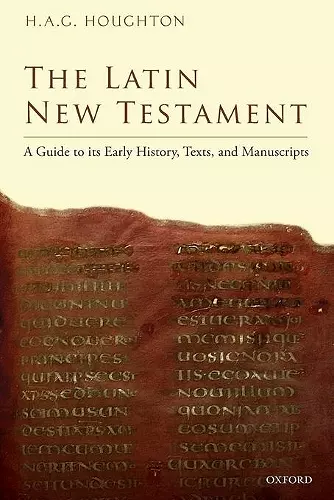The Latin New Testament
A Guide to its Early History, Texts, and Manuscripts
Format:Paperback
Publisher:Oxford University Press
Published:5th Oct '18
Currently unavailable, and unfortunately no date known when it will be back

This is an open access title available under the terms of a CC BY-NC-ND 4.0 licence. It is free to read at Oxford Scholarship Online and offered as a free PDF download from OUP and selected open access locations. Latin is the language in which the New Testament was copied, read, and studied for over a millennium. The remains of the initial 'Old Latin' version preserve important testimony for early forms of text and the way in which the Bible was understood by the first translators. Successive revisions resulted in a standard version subsequently known as the Vulgate which, along with the creation of influential commentaries by scholars such as Jerome and Augustine, shaped theology and exegesis for many centuries. Latin gospel books and other New Testament manuscripts illustrate the continuous tradition of Christian book culture, from the late antique codices of Roman North Africa and Italy to the glorious creations of Northumbrian scriptoria, the pandects of the Carolingian era, eleventh-century Giant Bibles, and the Paris Bibles associated with the rise of the university. In The Latin New Testament, H. A. G. Houghton provides a comprehensive introduction to the history and development of the Latin New Testament. Drawing on major editions and recent advances in scholarship, he offers a new synthesis which brings together evidence from Christian authors and biblical manuscripts from earliest times to the late Middle Ages. All manuscripts identified as containing Old Latin evidence for the New Testament are described in a catalogue, along with those featured in the two principal modern editions of the Vulgate. A user's guide is provided for these editions and the other key scholarly tools for studying the Latin New Testament.
The work is an astounding achievement for its breadth, concision, and wealth of material introduced. In light of the authors obvious care for the subject, readers may well expect to follow his exemplary scholarship for many years to come. * Joseph Grabau, Augustiniana 67:3.4 *
Houghton has succeeded in writing a book that prepares and equips students and scholars to study the Latin New Testament. Readers who have a familiarity with the textual criticism and Latin will find the book to be accessible and easy to understand, but even those with no knowledge in these areas will benefit from reading this book. Thus, Houghton has made a significant contribution to the field of textual criticism, and his book should be used by anyone seeking an introduction or guide to the Latin New Testament. * Benjamin Browning, The Journal for Baptist Theology and Ministry *
The book's orientation of the reader in not only the manuscripts but also the scholarship is an enormous service: most scholars will probably find something they were unaware of that will answer a lingering question in their minds ... This is the most useful kind of scholarship: readable, informative, and engaging. It summarizes a vast swathe of literature and makes it accessible to others, overturning widely held misconceptions, and showing how we can get far more information out of the Latin New Testament and its manuscripts. This book is required reading for anyone studying the New Testament, patristic and medieval literature, or biblical manuscripts. It is deserving of a home in any humanities library. * Andrew Dunning, Bryn Mawr Classical Review *
Houghton has produced a magisterial piece of scholarship and has done so in a way that is sure to benefit scholars and students alike. He has given a wide audience a clear introduction to the history and significance of the Latin New Testament as well as an invaluable reference text for the manuscripts of the LNT. As an introduction, the book is clear and concise; as a reference work, it is easy to navigate and decipher. Houghton has, without a doubt, produced a standard work for the present period of textual criticism which is taking place with renewed vigor. * Stephen D. Campbell, Centre for Research of Biblical Manuscripts *
The book is attractively produced, with photographs of some of the most interesting manuscripts ... [it] looks likely to be a standard resource for some time. * Colin McDonald, Classics for All *
[I] would like to emphasise the competence of the author who succeeds in marrying synthetic views and precision. This guide will be of great value to scholars in patristic and biblical studies. * Pierre-Maurice Bogaert, Journal of Ecclesiastical History *
ISBN: 9780198800651
Dimensions: 234mm x 162mm x 21mm
Weight: 592g
400 pages